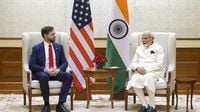In a significant development for international trade, India and the United States have finalized the terms of reference (ToR) that outline the roadmap for negotiations of the proposed Bilateral Trade Agreement (BTA). This announcement was made following a pivotal meeting between U.S. Vice President J.D. Vance and Indian Prime Minister Narendra Modi in New Delhi on April 21, 2025.
U.S. Trade Representative (USTR) Jamieson Greer expressed optimism about the ongoing negotiations, emphasizing that these talks aim to open new markets for American goods while addressing practices deemed unfair to U.S. workers. "India's constructive engagement so far has been welcomed, and I look forward to creating new opportunities for workers, farmers, and entrepreneurs in both countries," Greer stated.
The meeting marked a historic moment as Vice President Vance became the first U.S. vice president to visit India in 12 years, a visit that follows Joe Biden's trip to New Delhi in 2013. The discussions between the two leaders were described as wide-ranging and productive, with both sides reporting significant progress toward a mutually beneficial trade pact.
The announcement of the finalized ToR comes after the two countries declared their intention to negotiate the BTA on February 13, 2025. The goal is to complete the first phase of the agreement by fall 2025, specifically by September or October. The USTR outlined that the United States seeks to increase market access, reduce tariffs and non-tariff barriers, and negotiate a robust set of additional commitments to ensure long-term benefits.
Despite the progress, the U.S. has long faced significant trade barriers with India, leading to a substantial trade deficit. In 2024, the U.S. recorded a $45.7 billion goods trade deficit with India, which represents a 5.1% increase from the previous year. The total goods trade between the two nations was estimated at $129.2 billion in 2024.
India's average applied tariff stands at 17%, significantly higher than the U.S. average of 3.3%. Furthermore, the average applied tariff rate on agricultural products is a staggering 39% in India, compared to just 5% in the United States. These disparities have long been a point of contention in trade discussions.
In light of these challenges, the U.S. welcomed the tariff reductions that India implemented during Prime Minister Modi's meeting with former President Donald Trump in February 2025. The U.S. has expressed hope for further reductions on U.S. products as part of the BTA.
The ToRs include key issues such as tariffs, non-tariff barriers, rules of origin, and customs facilitation, all of which are critical to establishing a fair and reciprocal trade relationship. Greer noted that the announcement of the ToR is a crucial step toward achieving reciprocal trade with one of the U.S.'s most strategic partners.
However, some observers have expressed skepticism regarding the progress of the negotiations. They point out that the announcement merely signifies the beginning of discussions on how to negotiate a trade deal rather than an actual agreement. This sentiment reflects a cautious approach to the unfolding trade relationship between the two nations.
As negotiations continue, both sides remain hopeful that the BTA will foster economic growth and create opportunities for businesses and workers in both countries. With the global economy increasingly interconnected, the outcome of these discussions could have far-reaching implications for international trade dynamics.
In summary, the finalized terms of reference represent a significant step forward in the U.S.-India trade relationship, laying the groundwork for future negotiations aimed at enhancing trade ties. As both nations work toward a comprehensive agreement, the focus will remain on addressing existing trade barriers and fostering a more balanced economic partnership.





